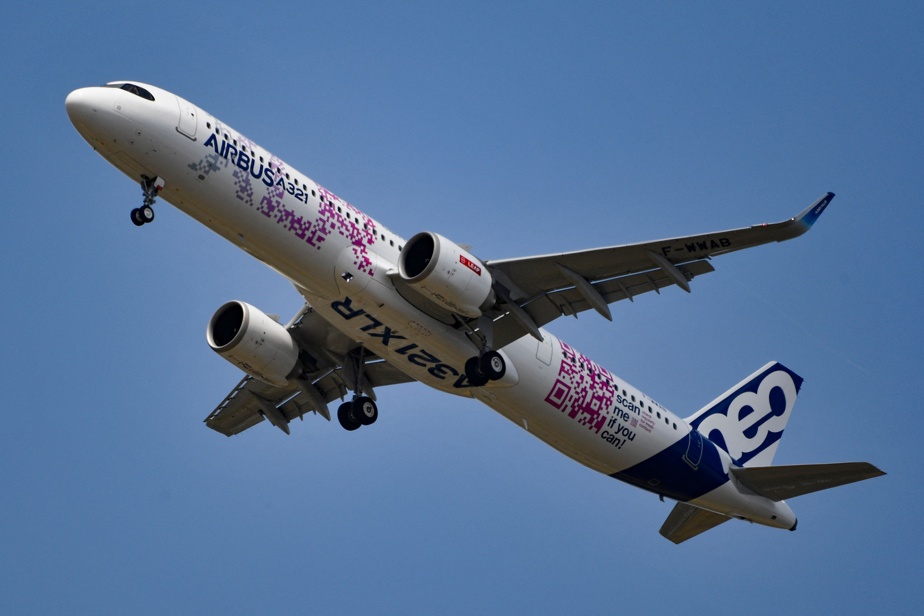(Paris) The A321 XLR, a single-aisle aircraft capable of long-haul routes traditionally reserved for wide-body aircraft, has obtained certification from the European air regulator, paving the way for its entry into service.
Derived from the A320 family and named XLR, for Extra Long Range, this aircraft makes it possible to operate with a single-aisle, saving money, routes that until now could only be operated by long-haul wide-body aircraft.
With a range of over 8,500 kilometres, it can make 11-hour flights, connecting, for example, Reykjavik to Dubai or London to Cape Town.
The Spanish company Iberia announced that it would receive the first aircraft “by the end of the summer” and that it would operate it from Madrid to Boston (northeastern United States).
The European aircraft manufacturer designed the XLR to attack the so-called “mid-market” segment, between medium-haul aircraft such as the Airbus A320 and Boeing 737 and large carriers (Airbus A330 and A350, Boeing 787 and 777), and until now occupied only by the Boeing 757, an aircraft which has not been produced for 20 years.
The aircraft has been a commercial success even before it entered service: since the programme was launched in 2019, Airbus has won more than 500 orders. The Indian low-cost airline IndiGo has bought 70 of them, while the US majors American Airlines and United have each bought 50.
The “type certificate” issued by the European Aviation Safety Agency (EASA) means that the aircraft meets all of the strict aviation safety requirements imposed by EASA. In concrete terms, it means that this model can carry commercial passengers.
The process will have required 900 hours of test flights and led to the production of 500 certification documents, according to EASA.
Certification by the other major global regulator, the US FAA, is taking place in parallel, with Airbus having incorporated its requirements during the process, according to the aircraft manufacturer.
Since the Boeing 737 MAX crisis, which revealed flaws in the authorities’ supervision process and the production and quality problems in which the American aircraft manufacturer remains embroiled, the certification process has been significantly tightened.
EASA and the FAA have been implementing new requirements along the way, “the last one was only formalized towards the end of last year,” 18 months after the XLR’s first flight, says Gary O’Donnell, head of the XLR program at Airbus.
Lower costs
“Our requirements can be very strict and pose significant challenges to the manufacturer, in this case Airbus. But our common objective is really to guarantee safety,” argues Florian Guillermet, the executive director of EASA, quoted in a press release.
The European aircraft manufacturer had to meet new regulatory requirements requiring the plane to land on its belly, as if it had no engines or landing gear, he explains.
However, to extend the A321 XLR’s reach, Airbus added an additional 12,900-litre tank located in the fuselage behind the wings.
“We extended the belly fairing to completely cover the rear center tank and significantly reinforced the structure,” he explains.
At the cost of additional weight which reduces the promised range of 4,700 miles (8,700 km) by “50 to 90 nautical miles” (93 to 167 km).
But only 10 to 20% of operations will be affected by this reduced autonomy and “we are working to regain it,” he assures.
For airlines, the A321 XLR could be a “game changer,” says Jérôme Bouchard, an aeronautics expert at Oliver Wyman.
“With operating costs and CO2 “With lower costs, but also probably operating costs related to the reduced number of pilots, they will be able to cross the Atlantic or go from one coast to another in the United States,” he explains.
And the aircraft will allow them to “test” new destinations and profitably develop low-traffic long-haul routes by carrying only between 172 and 244 passengers depending on the configuration, around a hundred fewer than with a wide-body aircraft.
“After that it remains a single-aisle, that is to say that there is little space, the cabin is relatively narrow,” he judges. A point of attention for such long flights.
But according to Gary O’Donnell, “in terms of passenger experience, the comfort feedback is very similar to what we have on the A330 neo.”
